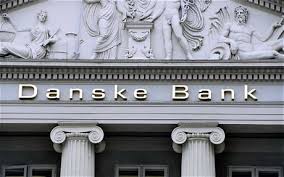Danske Bank Reprimanded by FSA for underestimating Risk of Loans

Denmark’s financial regulator reprimanded Danske Bank A/S for underestimating the risk of losses in a part of its retail lending business.
Denmark’s biggest lender couldn’t prove a group of consumer debt assets deserved a lower risk weighting than other loans, the Copenhagen-based Financial Supervisory Authority said yesterday. It ordered Danske, Scandinavia’s second-largest bank by assets, to raise its risk-weighted retail assets by 2.7 billion kroner ($485 million).
“This is a focus area,”Kristian Vie Madsen, deputy director at the Danish FSA, said by phone. Stricter capital rules “help very little if banks are then able to decrease their risk-weighted assets” without “also having decreased risk,” he said.
The reprimand marks the second time Danske has been ordered to correct its stock of risky assets in 13 months, adding to the bank’s capital requirement. The FSA in June last year ordered Danske to raise mostly corporate risk-weighted assets by as much as 100 billion kroner. Danske this year dropped an appeal against that order, which raised the bank’s capital requirement by $1.1 billion.
The two FSA orders aren’t related, according to Danske.
‘Taken Note’
“We have taken note of the order and have made the necessary adjustments,” Peter Rostrup-Nielsen, Danske’s chief risk officer, said in an e-mailed response to questions.
The FSA’s latest order left Danske’s total capital ratio largely unchanged at 18.1 percent of risk-weighted assets as of March 31, the FSA said. The ratio was 18.6 percent as of June 30.
Danske shares fell 0.4 percent in Copenhagen to 160.60 kroner at 9:44 a.m., extending yesterday’s 1.3 percent decline. The stock has gained 29 percent this year, outperforming a 19 percent advance in the Nasdaq OMX Copenhagen 20 index. (KFX)
Danske was one of four banks the FSA said failed to assign the correct risk weights to consumer loans. The other banks are Jyske Bank A/S, Nykredit A/S and Laan & Spar Bank A/S.
The FSA ordered Jyske, Denmark’s second-largest listed bank, to raise its risk-weighted assets by 1.1 billion kroner, reducing its total capital ratio to 16 percent from 16.2 percent. Nykredit was ordered to raise its risk-weighted retail assets by 1.3 billion kroner; its capital ratio of 18.3 percent was largely unaffected, the FSA said.
Internal Models
Laan & Spar Bank, a community bank, suffered the biggest blow after it was ordered to raise its consumer loan book by 623 million kroner, reducing its total capital ratio to 16.4 percent from 18.3 percent reported in March.
The lenders, which use internal models for gauging risk, received permission in 2008 to use the lower weighting for so-called qualifying revolving retail exposures. These are typically credit cards and overdraft accounts, the FSA said.
A condition for doing so was that the lenders could prove that losses in the portfolio varied less than for other consumer debt. It was a condition they failed to meet, the FSA said. The decision followed a review that started last year, encompassing data dating as far back as 2007.
“It is important for us to have a focus on that — that they don’t understate their risk-weighted assets,” Madsen said. “We look at both individual banks and, in this example, at a group of banks. It depends on what makes sense.”
Under Scrutiny
Banks’ risk-weighting practices are coming under increased scrutiny across the globe as governments seek to avert a repeat of the worst financial crisis since the Great Depression. The European Central Bank is conducting an unprecedented investigation into the asset valuations of 128 of the region’s largest banks. Denmark’s FSA is working with the European Banking Authority to assess Danish lenders, Madsen said.
“We will also be looking at bank lending: when they grant loans, what are their processes, which are the most willing to grant loans?” he said. Benchmarking lenders against each other is an “important tool,” he said.
“Benchmarking isn’t saying that everyone has to be equal,” Madsen said. “But you should be able to understand what causes the differences and that there is a good explanation of the differences.”
Source: bloomberg





























